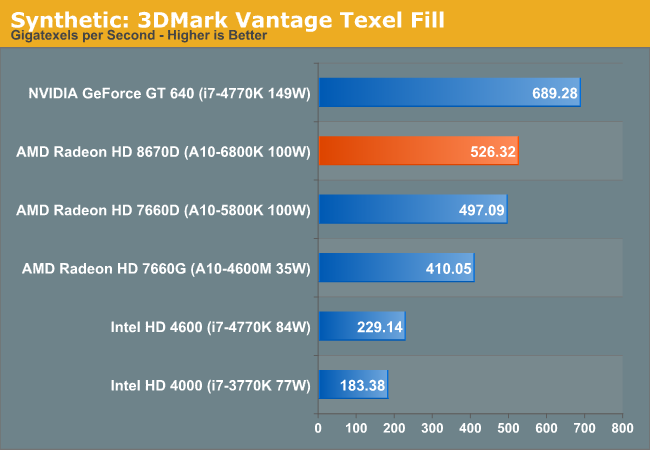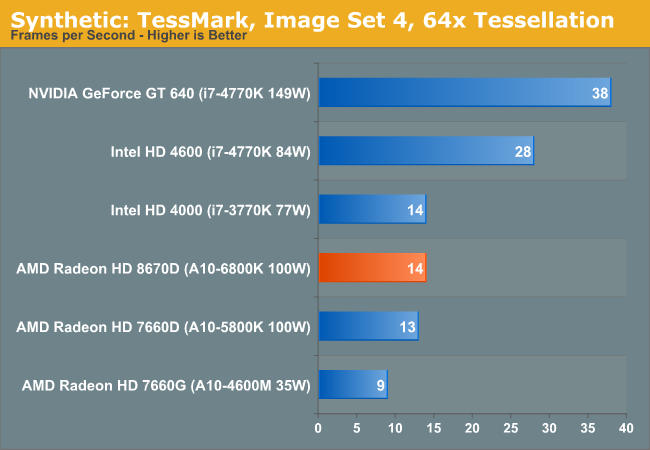AMD's Richland vs. Intel's Haswell GPU on the Desktop: Radeon HD 8670D vs. Intel HD 4600
by Anand Lal Shimpi on June 6, 2013 12:00 PM ESTSynthetics
Our synthetic benchmarks can sometimes tell us a lot about what an architecture is capable of. We'll turn to 3DMark Vantage first to stress ROP and texel rates.

Moving on, we have our 3DMark Vantage texture fillrate test, which does for texels and texture mapping units what the previous test does for ROPs.

Haswell could use some extra texture hardware, here Richland delivers more than 2x the peak textured fill rate of Haswell GT2.
Finally we’ll take a quick look at tessellation performance with TessMark.

As we saw in our Iris Pro review, Hawell's tessellation performance is surprisingly good.










102 Comments
View All Comments
coder543 - Thursday, June 6, 2013 - link
Why are we not testing versus Crystalwell enabled Iris 5200? This is the most important information, even if it isn't in the same price category necessarily.testbug00 - Thursday, June 6, 2013 - link
Because that makes no sense as a testing point.The i7 tested is not in the same price gap ether (an i3 would probably lose a lot of this partial CPU stuff) but the iGPU performance barely changes.
And how is that the most important information????? If anything it is the least important as you cannot buy Iris (pro) iGPU 5x00 on desktop unless embedded.
JarredWalton - Thursday, June 6, 2013 - link
The bigger factor is that Iris Pro simply isn't available as a desktop part -- it's only available in the BGA package i7-4770R, which OEMs can use in things like all-in-one PCs. The other place where we'll see Iris Pro (for now) is on laptops with the HQ series parts, but again that's not going up against desktops. GT3 and GT3e effectively don't exist as desktop offerings right now, but that's not too surprising as laptops stand to benefit most from improved iGPUs.jeffkibuule - Thursday, June 6, 2013 - link
On the desktop, it's only in one SKU that's only for OEM systems.FriendlyUser - Thursday, June 6, 2013 - link
Let me remind you that the Iris5200 is a $650 part. In fact, the ONLY situation where the Crystalwell part makes sense is when TDP and power requirements/battery concerns are the absolute priority. Otherwise, it's much cheaper to get a non-iris part and a separate mobile gpu (say, radeon 8970M) that offers vastly superior performance.mikk - Thursday, June 6, 2013 - link
No this is wrong. Iris Pro starts at 440 USD in mobile. Crossfire is not comparable since you get horrible micro stuttering.Hrel - Thursday, June 6, 2013 - link
They fixed the stuttering a long time ago mikkGigaplex - Thursday, June 6, 2013 - link
It wasn't that long ago and it's still not completely fixed.Guspaz - Friday, June 7, 2013 - link
They improved the stuttering for single GPU use. Both nVidia and AMD suffer from micro stuttering with multi-GPU solutions. It's a different problem set.Samus - Friday, June 7, 2013 - link
AMD is worse than nVidia's stuttering, but is easily fixed by adding a third GPU. So instead of using two high end cards in Crossfire/SLI, using three mid-high end cards virtually eliminates stutter.